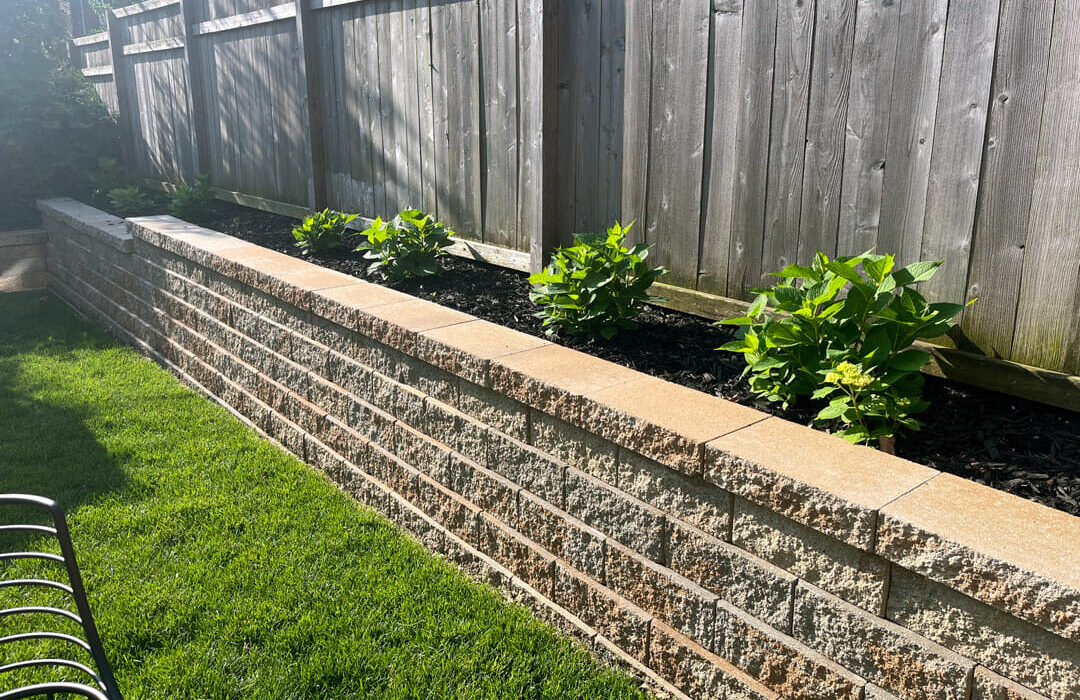How to Cut Grass Against a Wall [3 Ways to Prevent Damage]
To avoid damaging a wall while trimming the grass growing alongside it, start by using a string trimmer. Hold the trimmer so that the string is cutting downwards at an angle. This will cut the grass without cutting into the wall. If this is difficult or impossible, you can instead dig a trench separating the grass from the wall. Then, you can mow along the trench and avoid using a trimmer altogether. To prevent grass from creeping into the no-grass zone between the lawn and the wall, consider making a permanent border with stones, bricks, or mulch.
What is the Best Tool to Edge Along a Wall?
A string trimmer is the best option for edging grass along a wall. Although string trimmers have a reputation for damaging walls, they’re actually less destructive than bladed trimmers. Manual edging tools are slow to use, take considerable energy, and struggle to cut certain grass types. With the techniques we discuss below, you can use a motorized string trimmer without cutting into your wall.
- A string trimmer provides the best balance of speed, maneuverability, and efficiency for trimming grass against a wall.
- Manual trimming tools are much slower and more labor-intensive.
- With the right techniques, a string trimmer won’t damage your wall.
- Always wear protective gear when using a string trimmer.
Both electric and gas string trimmers are good options for cutting tall grass where your lawn edges meet a wall. Electric trimmers typically have less power, which may be a benefit in this case, since they’re even less likely to harm your wall. Just make sure to wear pants, long sleeves, goggles, and hearing protection whenever you are operating a trimmer.
3 Ways to Safely Cut Grass Growing Against a Wall
Edging grass that grows along the wall of your home or another structure can be frustrating. It can seem almost impossible to cut long blades of grass without scarring the wall. Here’s how to cut grass without harming your wall:
Angle Your String Trimmer
When cutting grass that is growing against a wall, tilt the trimmer so that the string is cutting downward, not sideways. A sideways cutting motion will cut marks into your wall. Instead, tilt the trimmer so it cuts downward at an angle. Aim to cut the grass at its base, so there is no chance the trimmer string makes visible marks on the wall. This will also prevent grass clippings from leaving green stains on your wall.
- Cut grass along a wall by holding your string trimmer so it cuts downward, not sideways.
- Use this downward cutting angle to trim tall grass right where it meets the soil.
- This angle will prevent marks and grass stains on your wall.
- Before using your string trimmer at this angle, you may need to adjust the trimmer guard and handle.
Using a string trimmer safely at a vertical angle may require a few adjustments to your trimmer. First, ensure your trimmer is fully turned off. Then, hold the trimmer at the angle you will use to cut the grass along the wall. If necessary, reposition the guard on the trimmer head. When held at this angle, the guard should be pointing upwards. This will prevent debris from being flung dangerously toward you. Second, reposition the lower handle of the trimmer to provide a comfortable grip in this position.
Dig a Drainage Trench
You may not need to use a string trimmer at all if you dig a small trench along your wall. A trench that is 4 to 6 inches wide (10–15 cm) is enough to separate the grass from the wall. The trench only needs to be 2 to 4 inches deep (5–10 cm). Just follow these simple steps to dig a trench. A hoe, mattock, or trenching shovel is the only tool you need for the job.
- Use a shovel, hoe, or mattock to dig a 4–6-inch wide trench along the wall.
- The trench should be 2–4 inches deep.
- After trenching, cut all the grass along the wall with your mower.
- Discharge grass away from the wall to avoid a mess and grass stains.
Once you have completed your trench, you can simply mow along the edge of the trench. This will make lawn care even faster, since you won’t have to use a trimmer at all in this area. Just make sure to mow with your discharge chute facing away from the wall. This way, the grass clippings won’t be blown against the wall. Discharging grass clippings against the wall can make a mess and leave green grass stains.
Install a Border Along the Wall
You can turn the trench along your wall into a permanent grass-free border to eliminate a lot of work. The quickest and easiest way to prevent grass from growing back into the trench is to fill it with mulch to a depth of 4 inches (10 cm). Lightweight, organic mulch is best, since it won’t be dangerously thrown around by a mower or trimmer. Bark mulch and nut hulls are among the best options. This way, you can mow and trim along the border without getting close enough to damage the wall.
- Install a border along your wall to keep grass away from the wall permanently.
- Dig a trench along the wall, then fill the trench with mulch for a quick fix.
- For a permanent border, use bricks, stones, or railroad ties.
To make your border even more permanent, consider installing bricks or stones along the wall, at its base. A line of mortared bricks running along your wall will stop grass from growing there. Doing this will instantly remove the risk of damaging your wall whenever you cut your lawn.
How Do You Cut Grass Against a Wall?
The best ways to cut grass growing along a wall are:
- Use a string trimmer—it’s faster and more efficient than other tools.
- Hold your string trimmer so it cuts at a downward angle to trim grass without harming your wall.
- Dig a 4-inch-wide trench along your wall, so you can easily cut grass without the risk of wall damage.
- Install a border of mulch, bricks, stone, or wood along the base of the wall so you can cut the grass without getting close to the wall.
These solutions are fast, practical, and inexpensive. Plus, you can easily try them one-by-one. If you don’t like the results with the string trimmer, dig a trench. If grass aggressively grows back in the trench area, simply fill the trench with mulch to create a border.

![Lawn Mower Cutting Uneven? [Here’s How to Fix It] 1 Riding Mower Cutting Crazy Uneven V0 Ecns58B3Iwgb1 Min](https://milehighlifescape.com/wp-content/uploads/2023/10/riding-mower-cutting-crazy-uneven-v0-ecns58b3iwgb1-min-150x150.jpeg)
